Collagen and Keratin Hydrolysates to Delay the Setting of Gypsum Plaster
Abstract
:1. Introduction
2. Materials and Methods
2.1. Materials
2.2. Methods
2.2.1. Protein Hydrolysates Preparation
2.2.2. Collagen and Keratin Hydrolysates Characterization
2.2.3. Gypsum Characteristics
3. Results
3.1. Protein Hydrolysates Characteristics

3.2. Delaying Setting Time of Plaster with Protein Hydrolysates Additives Concentrations
3.3. The Conductivity of Gypsum Suspensions in Water
3.4. The Evolution of Temperature in Gypsum Paste
3.5. The Hardened Paste Density
3.6. Bending and Compressive Strengths of Plasters
4. Discussion
5. Conclusions
Supplementary Materials
Author Contributions
Funding
Institutional Review Board Statement
Informed Consent Statement
Data Availability Statement
Conflicts of Interest
References
- Available online: https://internationalleathermaker.com (accessed on 21 August 2022).
- Available online: https://www.euroleather.com/about-us/statistics (accessed on 21 August 2022).
- Buljan, J.; Reich, G.; Ludvik, J. Mass Balance in Leather Processing, Regional Programme for Pollution Control in the Tanning Industry in South-East Asia. US/RAS/92/120. 2000. Available online: https://media.oiipdf.com/pdf/0d585d37-98c8-4cfa-a9db-8e95b274b850.pdf (accessed on 1 October 2022).
- Pati, A.; Chaudhary, R.; Subramani, S. A Review on Management of Chrome-Tanned Leather Shavings: A Holistic Paradigm to Combat the Environmental Issues. Environ. Sci. Pollut. Res. 2014, 21, 11266–11282. [Google Scholar] [CrossRef] [PubMed]
- Kanagaraj, J.; Velappan, K.C.; Chandra Babu, N.K.; Sadulla, S. Solid Wastes Generation in the Leather Industry and Its Utilization for Cleaner Environment—A Review. J. Sci. Ind. Res. 2006, 65, 541–548. [Google Scholar]
- De Rosa-Giglio, P.; Fontanella, A.; Gonzalez-Quijano, G.; Ioannidis, I.; Nucci, B.; Brugnoli, F. Product Environmental Footprint Category Rules, 25 April 2018. Available online: https://ec.europa.eu/environment/eussd/smgp/pdf/PEFCR_leather.pdf (accessed on 7 October 2022).
- Tegtmeyer, D.; Wynne, B. Update X-Biomer INSITU®. In Proceedings of the 7th Freiberg Leather Days, Freiberg, Germany, 13–14 June 2018. [Google Scholar]
- Towards a circular economy: A zero waste programme for Europe /* COM/2014/0398 final/2 */ Document 52014DC0398R(01).
- Buljian, J.; Kral, I. The Framework for Sustainable Leather Manufacture. Available online: https://framework_for_sustainable_leather_manufacture_v12_2015.pdf (accessed on 14 October 2022).
- Hendriksen, W.E. Zeology tanning; Compostable leather and biodegradable waste. In Proceedings of the 10th Freiberg Days, Freiberg, Germany, 10–11 May 2022; Available online: neratanning.com/circular (accessed on 14 October 2022).
- Battaglia, A.; Poles, E.; Taccon, A.; Gotti, M. Bio-Circular Tanning System For The Production Of 100% Recyclable Leather Sneakers. In Proceedings of the III IULTCS EuroCongress, Rinascimento The Next Leather Generation, Vicenza, Italy, 18–20 September 2022; pp. 141–149. [Google Scholar]
- Esquerra-Resa, S.; Esquerra -Dot, S.; Garcia, A.; Moreno, À.; Mir, T.; Bacardit, A. Sudy of a Biodegradable Tanning Using Zeolites. In Proceedings of the Innovative Aspects for Leather Industry, IAFLI 2021, Izmir, Turkiye, 25–26 November 2021. [Google Scholar]
- Zoccola, M.; Montarsolo, A.; Mossotti, R.; Patrucco, A.; Tonin, C. Green hydrolysis as an emerging technology to turn wool waste into organic nitrogen fertilizer. Waste Biomass Valorization 2015, 6, 891–897. [Google Scholar] [CrossRef]
- Reddy, C.C.; Irshad Ahamad Khilji, I.A.; Gupta, A.; Bhuyar, P.; Mahmood, S.; AL-Japairai, K.A.S.; Chua, G.K. Valorization of keratin waste biomass and its potential applications. J. Water Process. Eng. 2021, 40, 101707. [Google Scholar] [CrossRef]
- Chen, Y.; Li, W.; Zhang, S. A multifunctional eco-friendly fertilizer used keratin-based superabsorbent as coatings for slow-release urea and remediation of contaminated soil. Prog. Org. Coat. 2021, 154, 106158. [Google Scholar] [CrossRef]
- Gaidau, C.; Stanca, M.; Niculescu, M.-D.; Alexe, C.-A.; Becheritu, M.; Horoias, R.; Cioineag, C.; Râp˘a, M.; Stanculescu, I.R. Wool Keratin Hydrolysates for Bioactive Additives Preparation. Materials 2021, 14, 4696. [Google Scholar] [CrossRef] [PubMed]
- Feroz, S.; Muhammad, N.; Ratnayake, J.; Dias, G. Keratin-Based materials for biomedical applications. Bioact. Mater. 2020, 5, 496–509. [Google Scholar] [CrossRef]
- Lazarus, B.S.; Chadha, C.; Velasco-Hogan, A.; Barbosa, J.D.V.; Jasiuk, I.; Meyers, M.A. Engineering with keratin: A functional material and a source of bioinspiration. iScience 2021, 24, 102798. [Google Scholar] [CrossRef] [PubMed]
- Kuckova, S.; Rambouskova, G.; Junkova, P.; Santrucek, J.; Cejnar, P.; Smirnova, T.A.; Novotny, O.; Hynek, R. Analysis of protein additives degradation in aged mortars using mass spectrometry and principal component analysis. Constr. Build. Mater. 2021, 288, 123124. [Google Scholar] [CrossRef]
- Kennedy, C.J.; Revie, W.A.; Troalen, L.; Wade, M.; Wess, T.J. Studies of hair for use in lime plaster: Implications for conservation and new work. Polym. Degrad. Stab. 2013, 98, 894–898. [Google Scholar] [CrossRef]
- Scheffler Silveira, V.; Silva de Vargas, A.; Hansen, É.; Robinson, L.C.; Thoen, N.A.; Muller de Quevedo, D.; Schneider, E.L.; Monteiro de Aquim, P. Novel solidification/stabilization process of wet blue leather waste to produce recycled lightweight aggregates. Waste Biomass Valorization 2022. [Google Scholar] [CrossRef]
- Parisi, M.; Nanni, A.; Colonna, M. Recycling of Chrome-Tanned Leather and Its Utilization as Polymeric Materials and in Polymer-Based Composites:A Review. Polymers 2021, 13, 429. [Google Scholar] [CrossRef] [PubMed]
- Krummenauer, K.; de Oliveira Andrade, J.J. Incorporation of Chromium-Tanned Leather Residue to Asphalt Micro-Surface Layer. Constr. Build. Mater. 2009, 23, 574–581. [Google Scholar] [CrossRef]
- Zainescu, G.; Deselnicu, V.; Constantinescu, R. Composite Structures Containing Leather Fibers with Applications in Constructions Industry. In Proceedings of the ICAMS 2018–7th International Conference on Advanced Materials and Systems, Bucharest, Romania, 18–20 October 2018; pp. 593–598. [Google Scholar]
- Available online: http//:www.bader-leather.com (accessed on 21 August 2022).
- Lukpanov, R.; Dyusembinov, D.; Shakhmov, Z.; Tsygulov, D.; Aibuldinov, Y.; Vatin, N.I. Impregnating Compound for Cement-Concrete Road Pavement. Crystals 2022, 12, 161. [Google Scholar] [CrossRef]
- Ding, X.; Shan, Z.; Long, Z.; Chen, Z. Utilization of collagen protein extracted from chrome leather scraps as a set retarders in gypsum. Constr. Build. Mater. 2020, 237, 117584. [Google Scholar] [CrossRef]
- Teoreanu, I. Bazele Tehnologiei Liantilor Anorganici; Imprimeria de Vest Oradea: Oradea, Romania, 1993. [Google Scholar]
- Teoreanu, I.; Georgescu, M.; Moldovan, V.; Muntean, M.; Puri, A. Bazele Fizico-Chimice Ale Intariri Liantilor Anorganici; Didactic and Pedagogical Publishing House: Bucharest, Romania, 1967; Available online: https://www.targulcartii.ro/galerie/cache/V072/ionmariavasilemar-bazele-fizico-chimice-ale-inta-didactica-si-pedagog-1972-a-878580-510x510.JPG (accessed on 1 September 2022).
- Craciuneanu, I.; Popa, E. Materiale de Constructii; Matrix Rom: Bucuresti, Romania, 1981. [Google Scholar]
- Available online: https://www.statista.com/statistics/264936/global-gypsum-production-by-major-countries/ (accessed on 20 June 2022).
- Klompong, V.; Benjakul, S.; Kantachote, D.; Shahidi, F. Antioxidative activity and functional properties of protein hydrolysate of yellow stripe trevally (Selaroides leptolepis) as influenced by the degree of hydrolysis and enzyme type. Food Chem. 2007, 102, 1317–1327. [Google Scholar] [CrossRef]
- Remko, M.; Fitz, D.; Rode, B.M. Effect of metal ions (Li+, Na+, K+, Mg2+, Ca2+, Ni2+, Cu2+ and Zn2+) and water coordination on the structure, and properties of L-histidine and zwitterionic L-histidine. Amino Acids 2010, 39, 1309–1319. [Google Scholar] [CrossRef]
- Chalamaiah, M.; Jyothirmayi, T.; Diwan, P.V.; Venu Babu, V.; Purnendu Kumar, S.; Dinesh Kumar, B. Nutritional composition, ACE-inhibitory, and metal chelating properties of rohu (Labeo rohita) egg protein hydrolysate produced by Alcalase. Int. Food Res. J. 2016, 23, 1017–1026. [Google Scholar]
- Sathe, S.K.; Salunkhe, D.K. Functional Properties of Great Northen Bean (Paeolus vulgaris L.) Protein: Emulsification Foaming, Viscocity and Gelation Properties. J. Food Sci. 1981, 46, 71–81. [Google Scholar] [CrossRef]
- SR EN 13729-2:2014; Romanian Adopted European Standard SR EN 13729-2:2014 Ipsos Şi Tencuieli Pe Bază De Ipsos. Partea 2: Metode de Încercare. ASRO: Bucharest, Romania, 2014. (In Romanian)
- SR EN 196-1:2016; Romanian Adopted European Standard SR EN 196-1:2016 Metode de Încercare Ciment. Partea 1: Determinarea Rezistenţei. ASRO: Bucharest, Romania, 2016. (In Romanian)
- Nagai, T.; Suzuki, N.; Tanoue, Y.; Kai, N. Collagen from Tendon of Yezo Sika Deer (Cervus nippon yesoensis) as By-Product. Food Nutr. Sci. 2012, 3, 72–79. [Google Scholar] [CrossRef] [Green Version]
- Yousefi, M.; Ariffin, F.; Huda, N. An alternative source of type I collagen based on by-product with higher thermal stability. Food Hydrocoll. 2017, 63, 372–382. [Google Scholar] [CrossRef]
- Muyonga, J.H.; Cole, C.G.B.; Duodu, K.G. Characterisation of acid soluble collagen from skins of young and adult Nile perch (Lates niloticus). Food Chem. 2004, 85, 81–89. [Google Scholar] [CrossRef]
- Oliveira, V.D.M.; Assis, C.R.D.; Costa, B.D.A.M.; Neri, R.C.D.A.; Monte, F.T.D.; Freitas, H.M.S.D.C.V.; França, R.C.P.; Santos, J.F.; Bezerra, R.D.S.; Porto, A.L.F. Physical, biochemical, densitometric and spectroscopic techniques for characterization collagen from alternative sources: A review based on the sustainable valorization of aquatic by-products. J. Mol. Struct. 2021, 1224, 129023. [Google Scholar] [CrossRef]
- Oslan, H.S.N.; Shapawi, R.; Mokhtar, R.A.M.; Noordin, W.N.M.; Huda, N. Characterization of Acid- and Pepsin-Soluble Collagen Extracted from the Skin of Purple-Spotted Bigeye Snapper. Gels 2022, 8, 665. [Google Scholar] [CrossRef]
- Sionkowska, A. The potential of polymers from natural sources. Pure Appl. Chem. 2015, 87, 1075–1084. [Google Scholar] [CrossRef]
- Peng, D.; Zhao, J.; Mashayekhi, H.; Xing, B. Adsorption of bovine serum albumin and lysozyme on functionalizedcarbon nanotubes. J. Phys. Chem. C 2014, 118, 22249–22257. [Google Scholar]
- Olariu, L.; Dumitriu, B.G.; Gaidau, C.; Stanca, M.; Tanase, L.M.; Ene, M.D.; Stanculescu, I.-R.; Tablet, C. Bioactive Low Molecular Weight Keratin Hydrolysates for Improving Skin Wound Healing. Polymers 2022, 14, 1125. [Google Scholar] [CrossRef]
- Zhang, W.; Huang, Z.L.; Liao, S.S.; Cui, F.Z. Nucleation sites of calcium phosphate crystals during collagen mineralization. J. Am. Ceram. Soc. 2003, 86, 1052–1054. [Google Scholar] [CrossRef]
- Alahmad, K.; Xia, W.; Jiang, Q.; Xu, Y. Effect of the Degree of Hydrolysis on Nutritional, Functional, and Morphological Characteristics of Protein Hydrolysate Produced from Bighead Carp (Hypophthalmichthys nobilis) Using Ficin Enzyme. Foods 2022, 11, 1320. [Google Scholar] [CrossRef]
- Kuroiwa, E.; Quy, N.X.; Hama, Y. Influence of Nanofibrillated Bacterial Cellulose on the Properties of Ordinary and Expansive Mortars. Materials 2022, 15, 2094. [Google Scholar] [CrossRef]
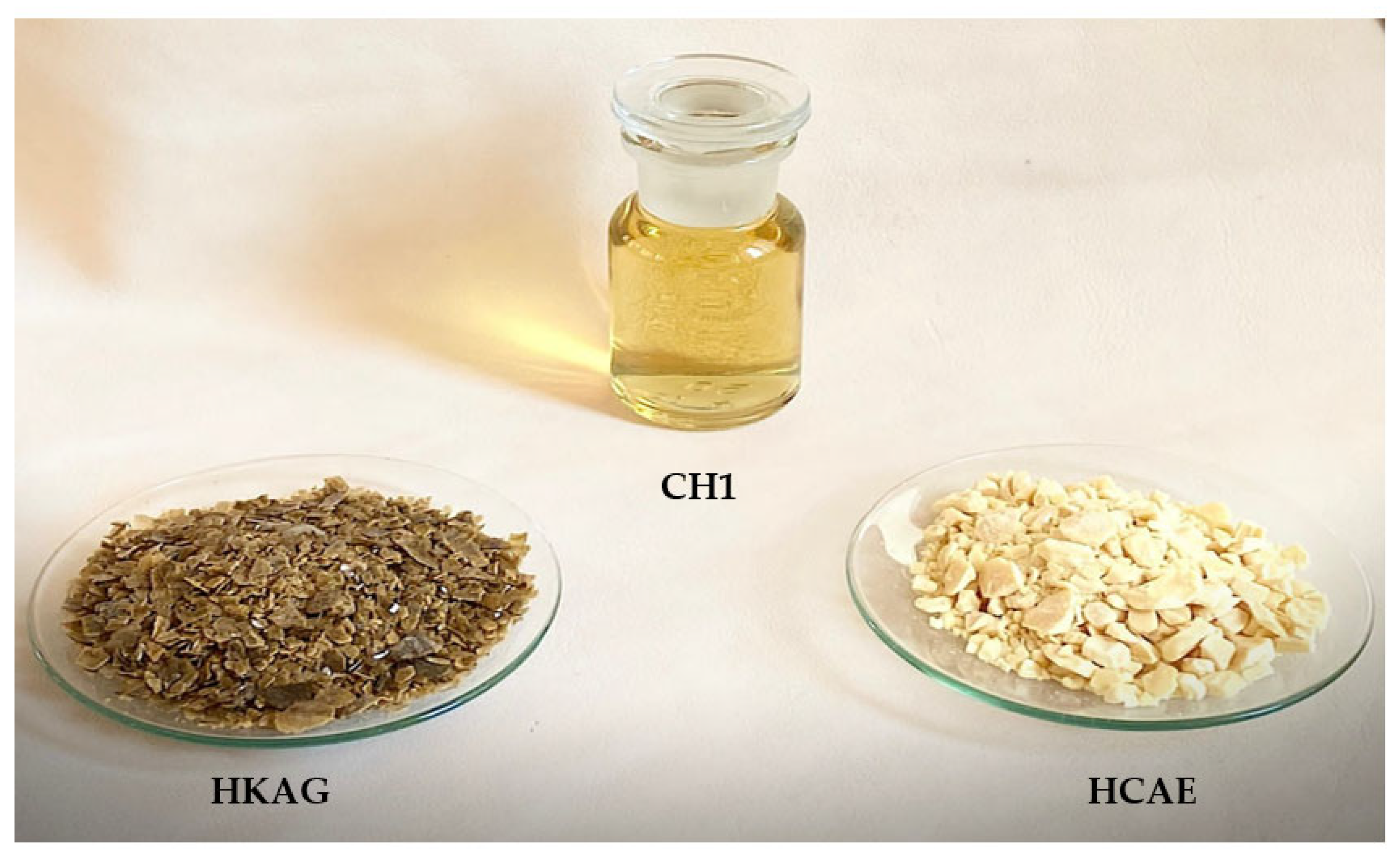
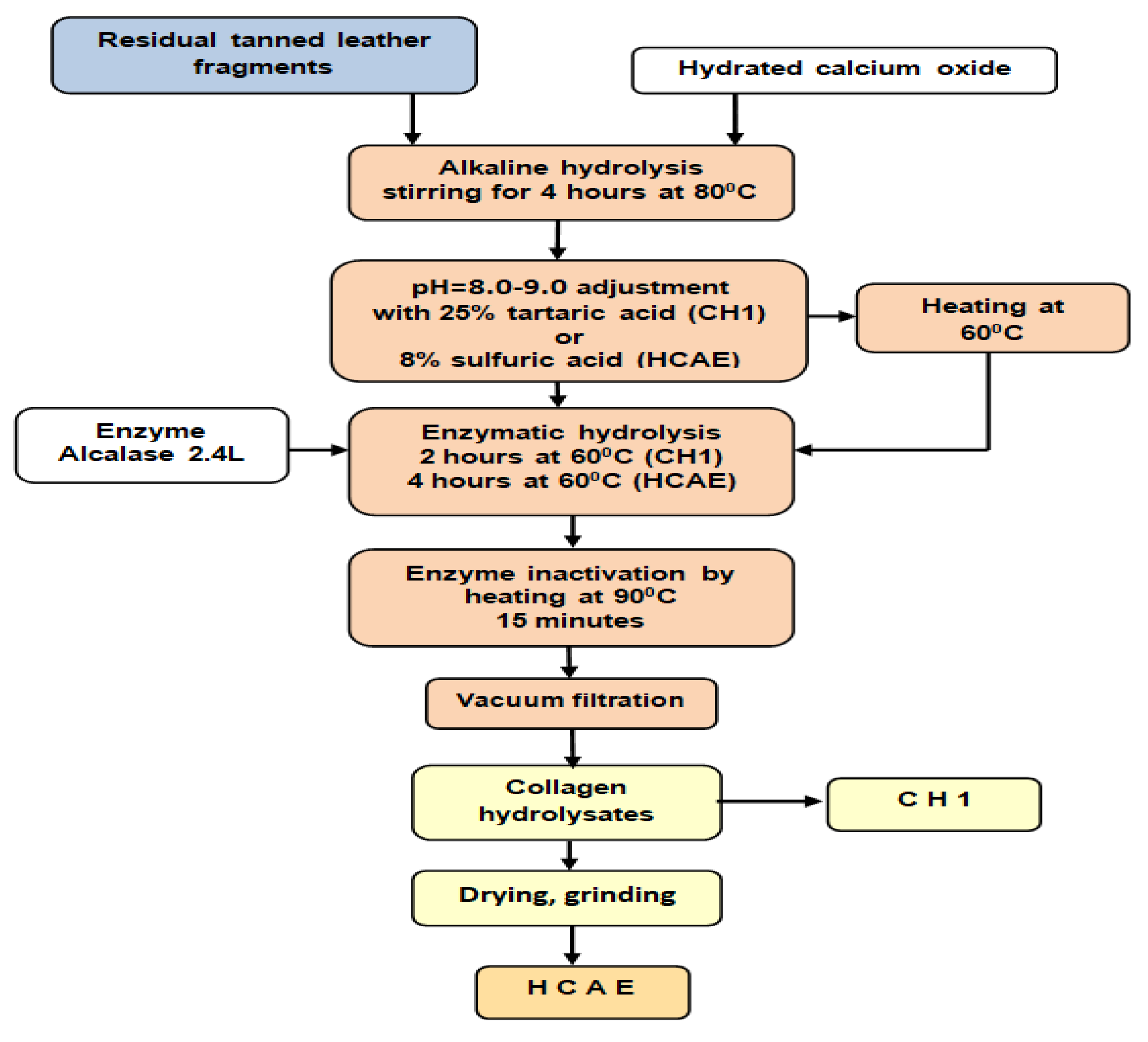
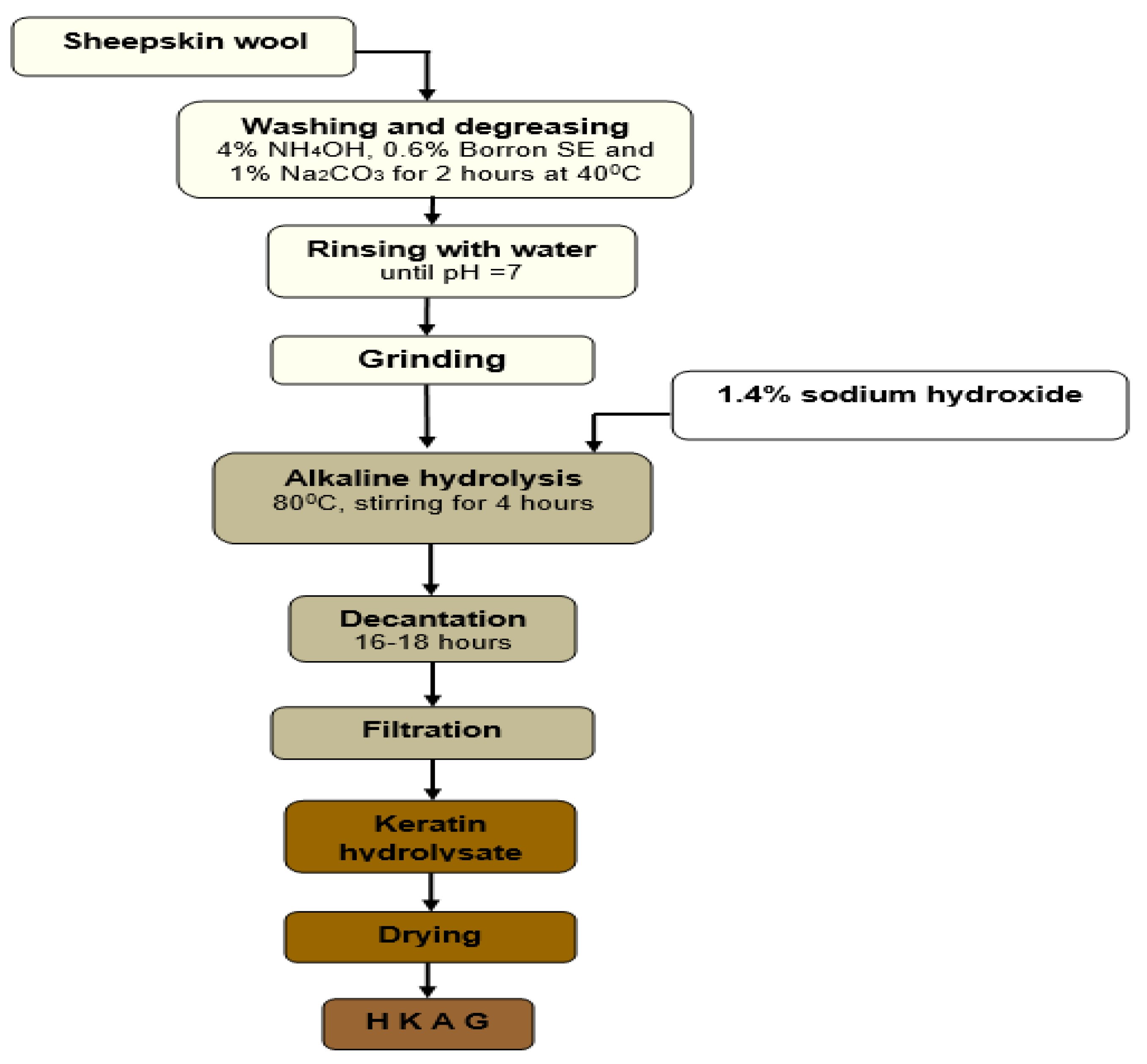
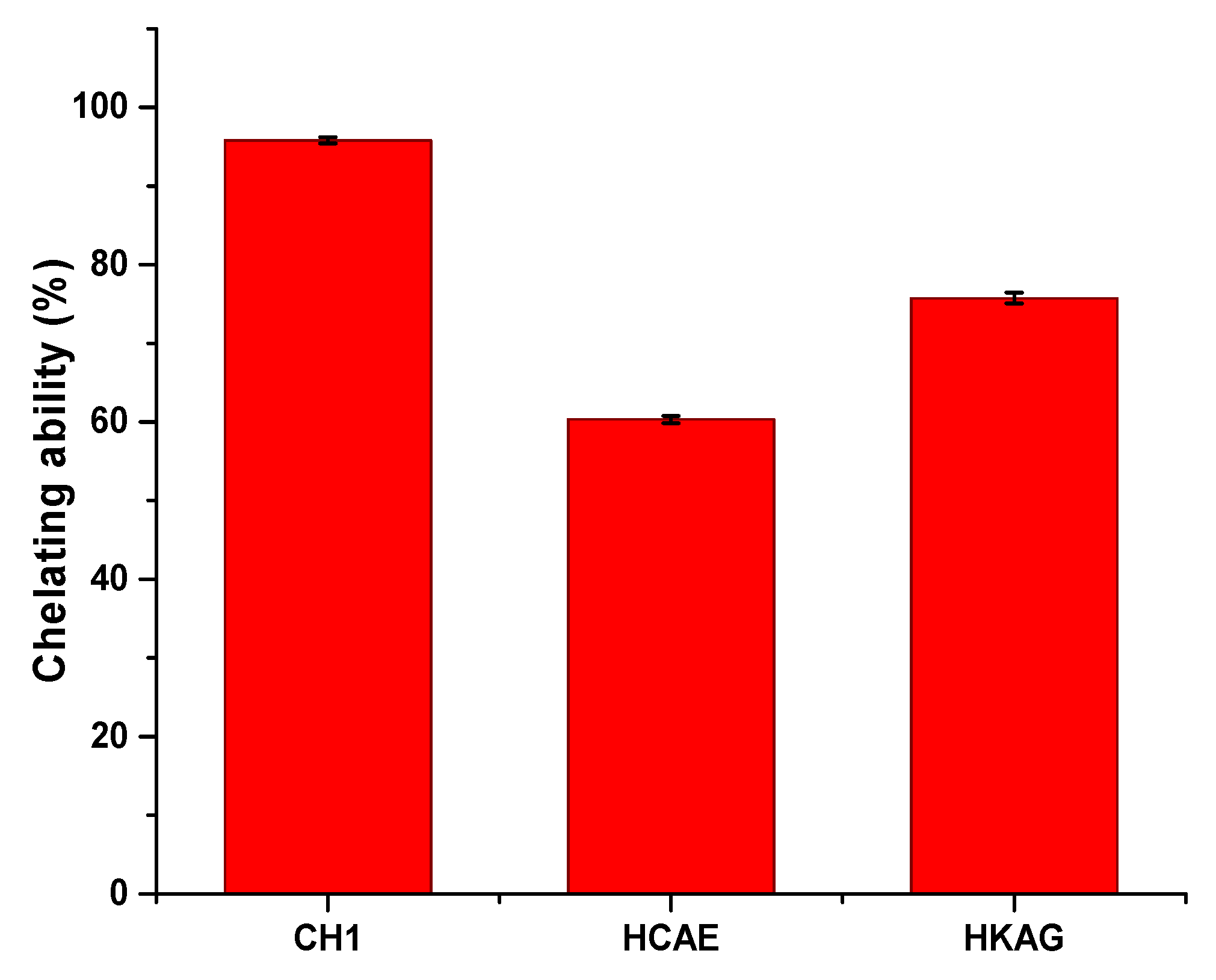
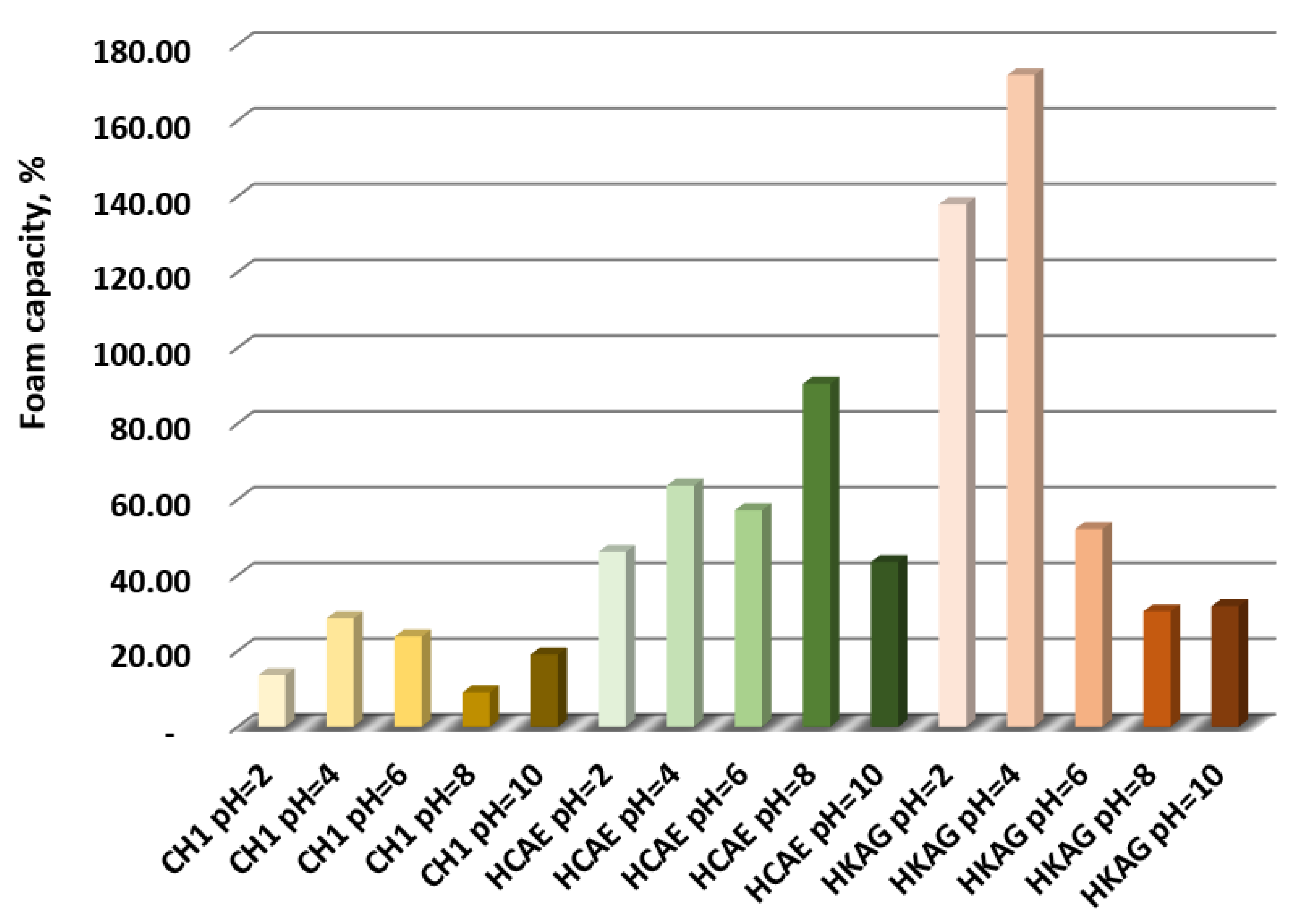
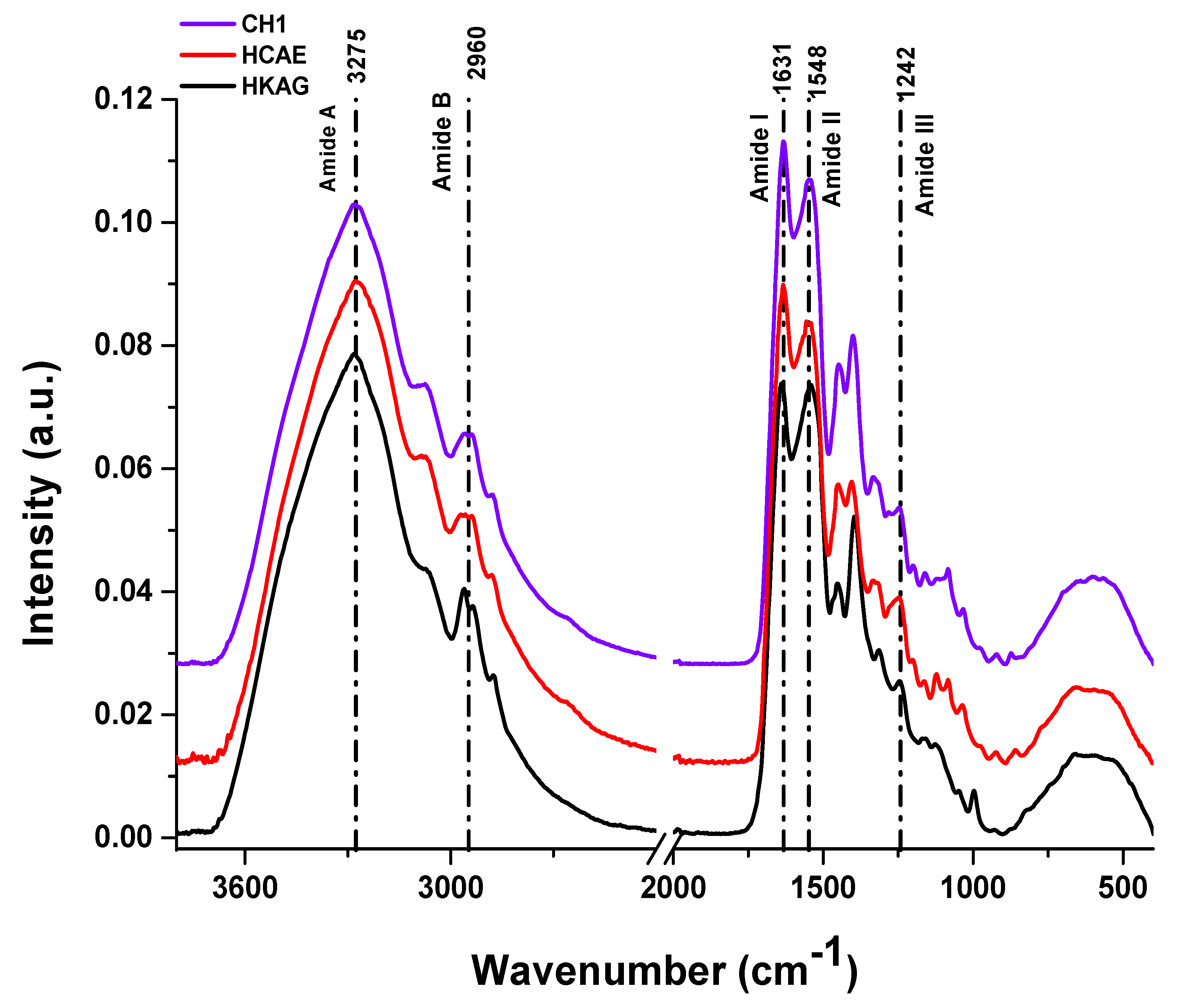
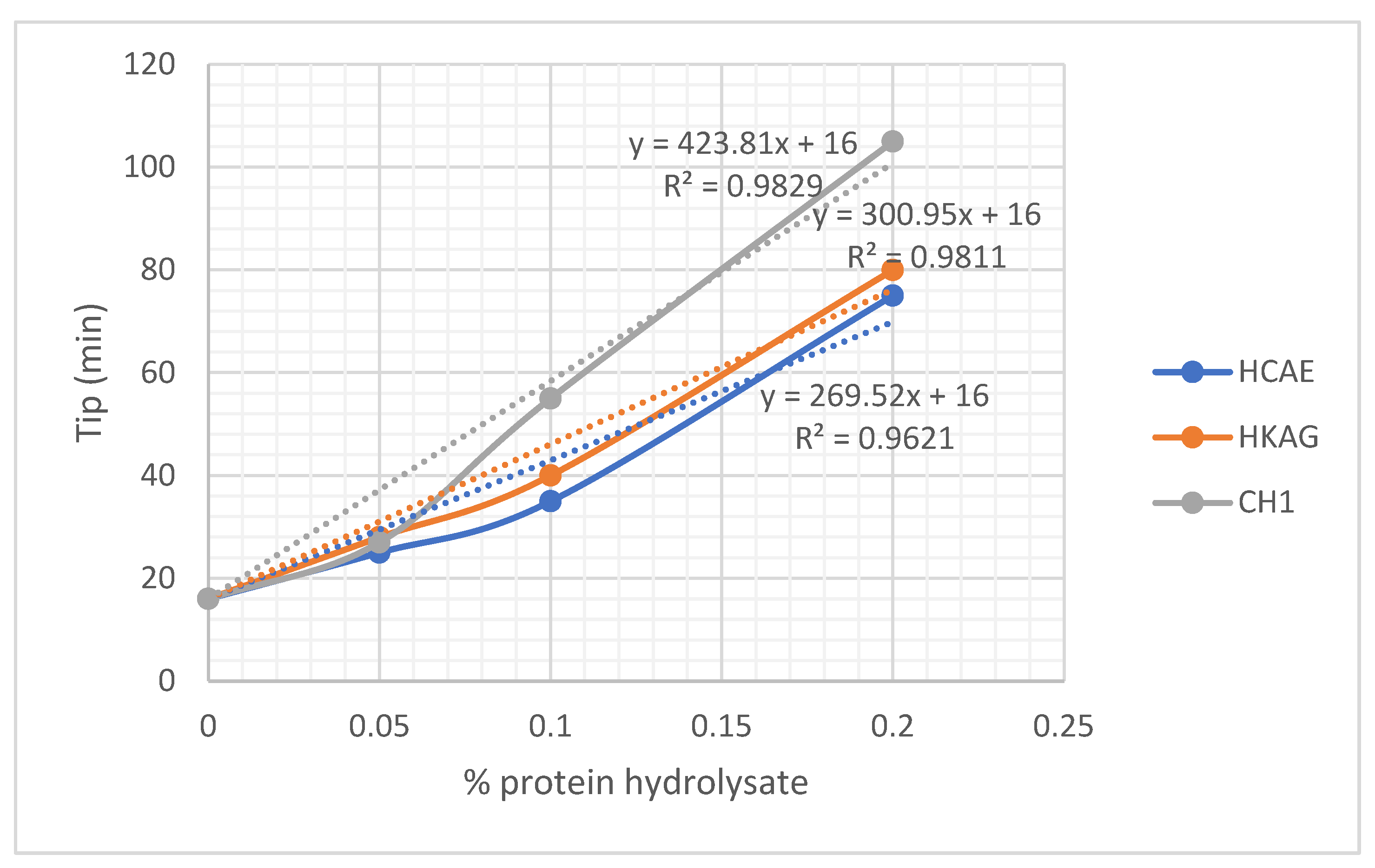
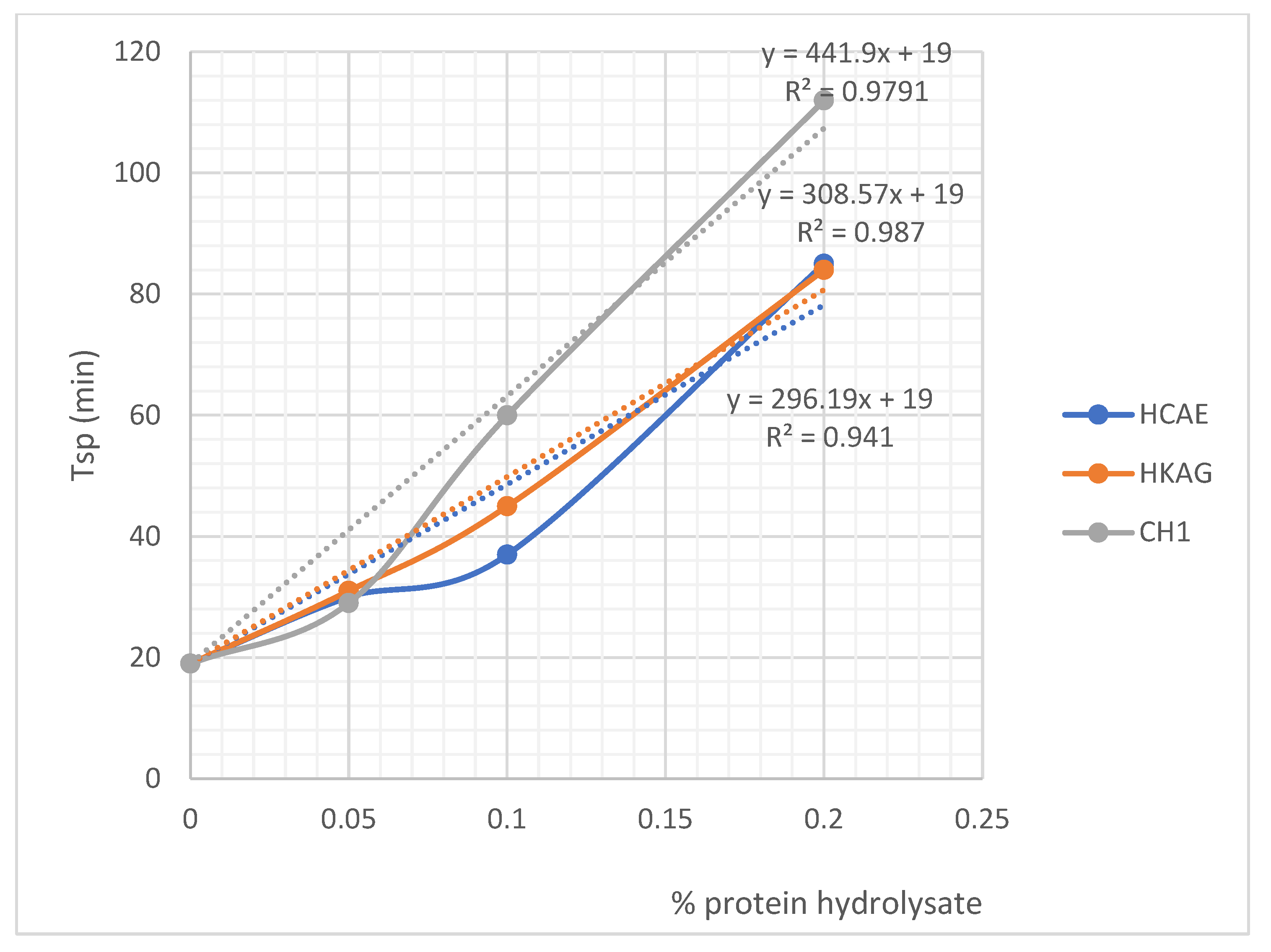
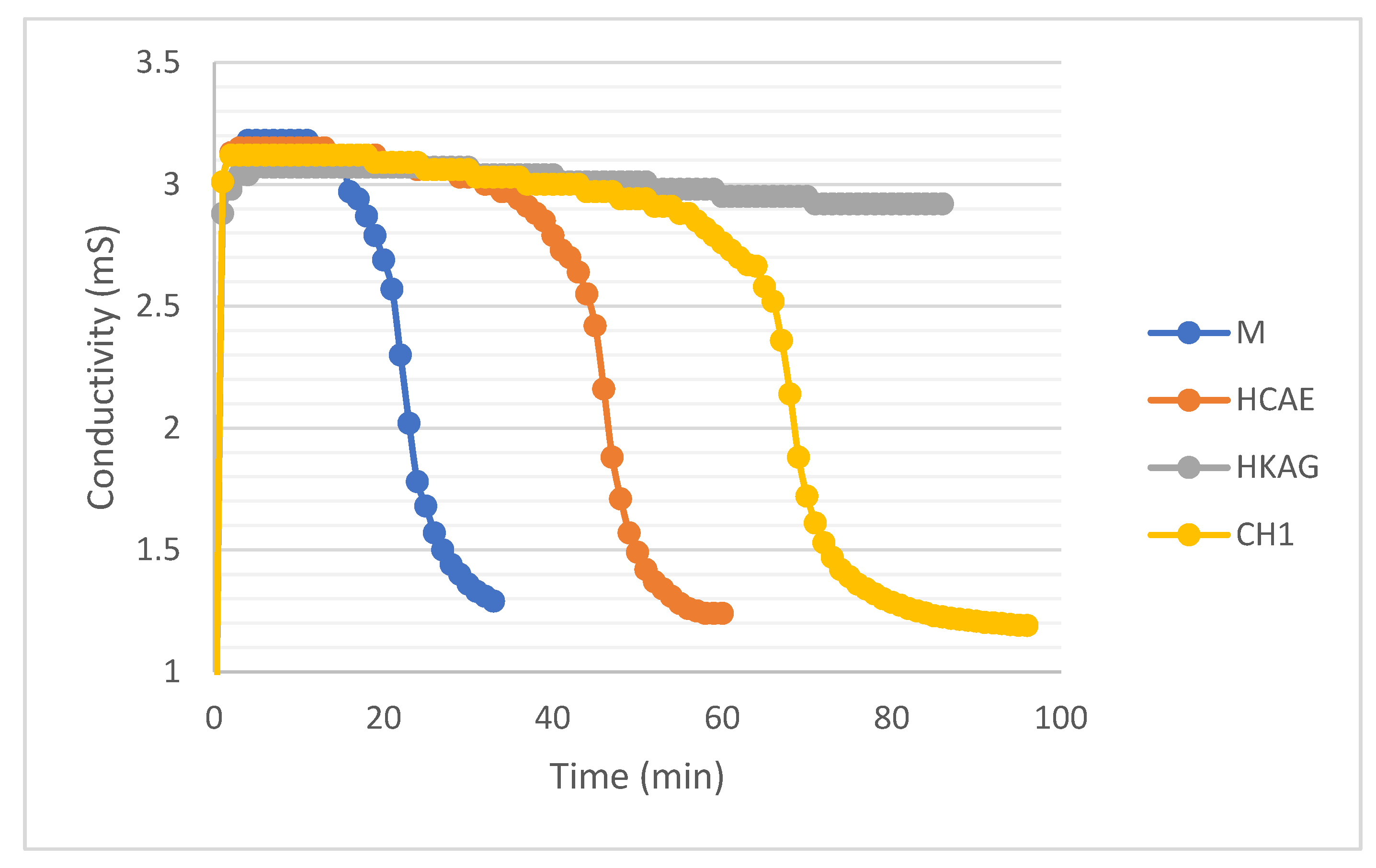
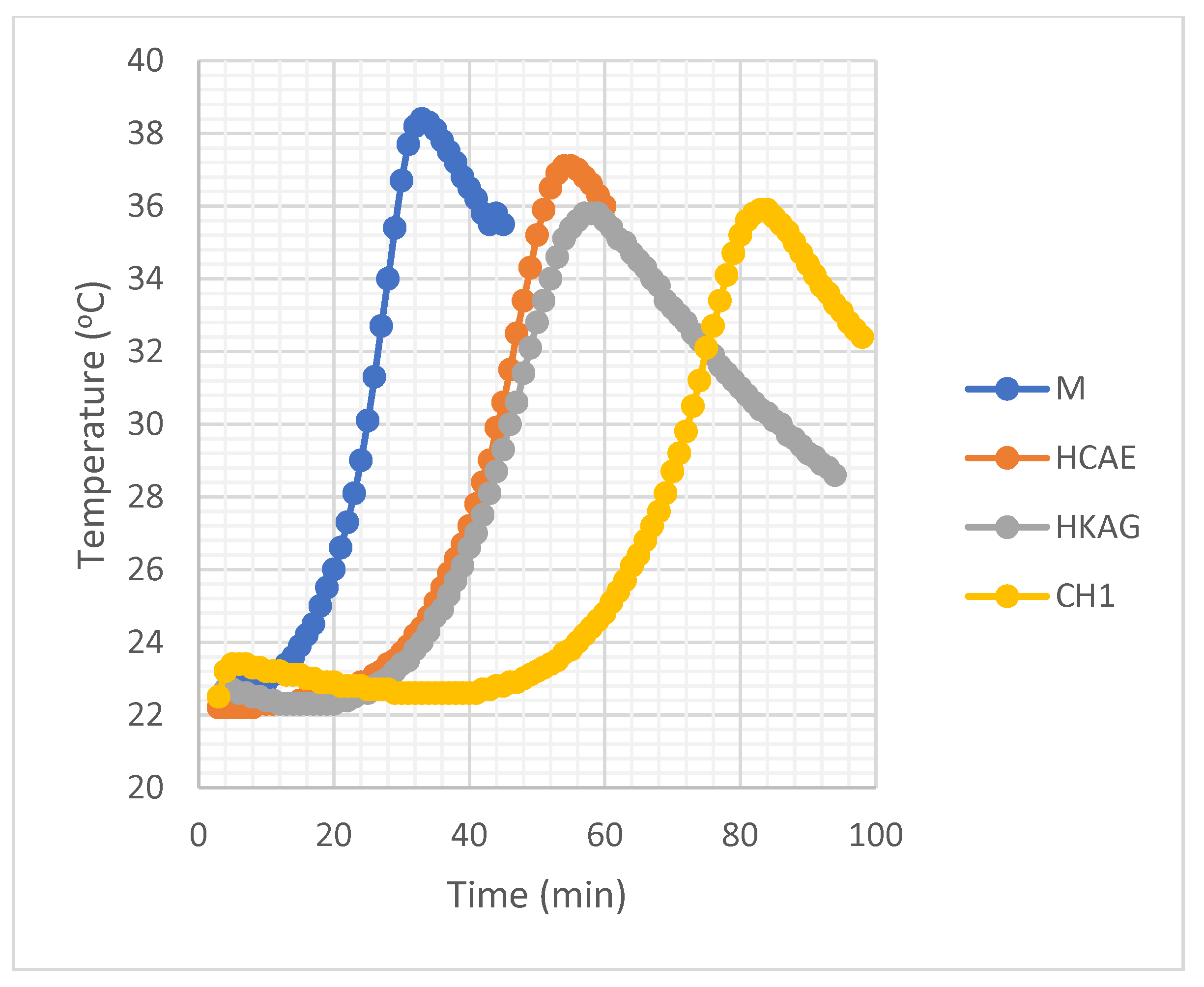

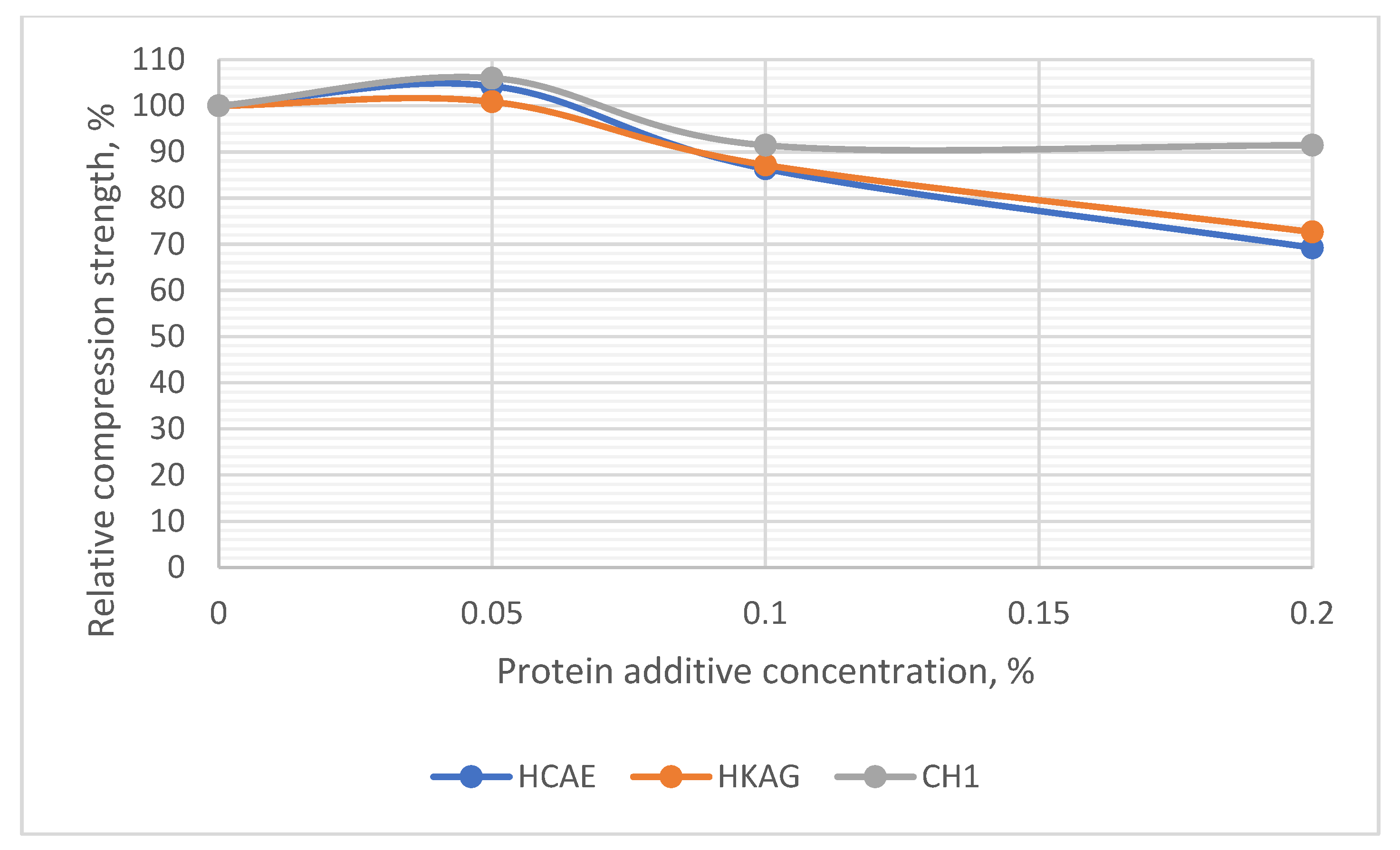
| Characteristics | Collagen Hydrolysate Dispersion, CH1 | Collagen Hydrolysate Granules, HCAE | Keratin Hydrolysate, Flakes, HKAG |
|---|---|---|---|
| Dry matter, % | 7.09 ± 0.42 | - | - |
| Volatile substances, % | - | 8.28 ± 0.42 | 10.97 ± 0.42 |
| Total nitrogen, % | 15.55 ± 0.66 | 13.31 ± 0.66 | 12.50 ± 0.66 |
| Protein, % | 87.45 ± 2.26 | 74.79 ± 2.26 | 75.75 ± 2.26 |
| Aminic nitrogen, % | 0.98 ± 0.12 | 1.40 ± 0.12 | 0.75 ± 0.12 |
| Average molecular weight, Da | 25,069 | 2530 | 13,433 |
| Polydispersity | 1.01 | 1.00 | 1.39 |
| Total sulfated ash, % | 11.98 ± 0.27 | 7.25 ± 0.27 | 14.40 ± 0.27 |
| Cr, mg/L | 39.30 ± 4.11 | - | |
| Cr, mg/kg | 78.68 ± 9.20 | - | |
| pH (1:10) | 10.10 ± 0.10 | 9.25 ± 0.10 | 10.30 ± 0.10 |
| Cysteine, % | - | - | 1.45 ± 0.03 |
| Cystine sulfur, % | - | - | 0.39 ± 0.03 |
| Electric conductivity, mS/cm | 5.96 ± 0.15 | 3.96 ± 0.26 | 7.12 ± 0.20 |
| Sample | Foam Stability, % | ||
|---|---|---|---|
| 30 min | 60 min | 90 min | |
| CH1 pH = 2 | 0 | 0 | 0 |
| CH1 pH = 4 | 0 | 0 | 0 |
| CH1 pH = 6 | 4.76 | 0 | 0 |
| CH1 pH = 8 | 0 | 0 | 0 |
| CH1 pH = 10 | 0 | 0 | 0 |
| HCAE pH = 2 | 0 | 0 | 0 |
| HCAE pH = 4 | 0 | 0 | 0 |
| HCAE pH = 6 | 0 | 0 | 0 |
| HCAE pH = 10 | 0 | 0 | 0 |
| HKAG pH = 2 | 6.90 | 3.45 | 3.45 |
| HKAG pH = 4 | 4 | 4 | 0 |
| HKAG pH = 6 | 0 | 0 | 0 |
| HKAG pH = 8 | 0 | 0 | 0 |
| HKAG pH = 10 | 0 | 0 | 0 |
| Amino Acid, g/100 g Protein | CH1 | HCAE | HKAG |
|---|---|---|---|
| Asp (D/N) | 5.60 ± 0.04 | 5.38 ± 0.09 | 8.30 ± 0.12 |
| Hyp | 10.69 ± 0.10 | 9.36 ± 0.08 | - |
| Thr (T) | 0.82 ± 0.007 | 0.84 ± 0.008 | 3.11 ± 0.01 |
| Ser (S) | 1.41 ± 0.002 | 1.37 ± 0.002 | 3.59 ± 0.009 |
| Glu (E/Q) | 10.72 ± 0.09 | 10.41± 0.09 | 19.21 ± 0.09 |
| Pro (P) | 14.09 ± 0.13 | 14.77 ± 0.12 | 7.49 ± 0.20 |
| Gly (G) | 23.28 ± 0.23 | 25.08 ± 0.23 | 7.66 ± 0.25 |
| Ala (A) | 9.86 ± 0.09 | 10.29 ± 0.08 | 6.54 ± 0.10 |
| Val (V) | 2.42 ± 0.02 | 2.36 ± 0.02 | 7.14 ± 0.01 |
| Met (M) | 0.99 ± 0.005 | 0.98 ± 0.005 | 1.23 ± 0.004 |
| Ile (+allo-Ile) (I) | 1.42 ± 0.005 | 1.44 ± 0.005 | 4.30 ± 0.002 |
| Leu (L) | 2.89 ± 0.015 | 2.80 ± 0.015 | 9.74 ± 0.005 |
| Tyr (Y) | 0.23 ± 0.009 | 0.29 ± 0.008 | 1.94 ± 0.003 |
| Phe (F) | 2.00 ± 0.002 | 1.89 ± 0.002 | 3.97± 0.001 |
| His (H) | 0.78 ± 0.006 | 0.66 ± 0.007 | 1.32 ± 0.003 |
| Hyl | 1.00 ± 0.001 | 0.94 ± 0.001 | - |
| Ornithine | 1.26 ± 0.002 | 1.05 ± 0.002 | 2.04 ± 0.001 |
| Lys (K) | 3.08 ± 0.003 | 3.10 ± 0.003 | 2.45 ± 0.004 |
| NH3 | 0.58 ± 0.002 | 0.59 ± 0.002 | 1.42 ± 0.001 |
| Arg (R) | 6.88 ± 0.006 | 6.40 ± 0.007 | 7.33 ± 0.004 |
| Cys(O3H) | - | - | 0.88 ± 0.001 |
| Cys | - | - | 0.34 ± 0.001 |
| Additive Concentration, % | Apparent Density, kg/m3 | ||
|---|---|---|---|
| HCAE | HKAG | CH1 | |
| 0.00 | 1168 | 1168 | 1168 |
| 0.05 | 1180 | 1153 | 1168 |
| 0.10 | 1163 | 1154 | 1171 |
| 0.20 | 1158 | 1163 | 1169 |
Publisher’s Note: MDPI stays neutral with regard to jurisdictional claims in published maps and institutional affiliations. |
© 2022 by the authors. Licensee MDPI, Basel, Switzerland. This article is an open access article distributed under the terms and conditions of the Creative Commons Attribution (CC BY) license (https://creativecommons.org/licenses/by/4.0/).
Share and Cite
Voinitchi, C.; Gaidau, C.; Capatana Tudorie, F.; Niculescu, M.; Stanca, M.; Alexe, C.-A. Collagen and Keratin Hydrolysates to Delay the Setting of Gypsum Plaster. Materials 2022, 15, 8817. https://doi.org/10.3390/ma15248817
Voinitchi C, Gaidau C, Capatana Tudorie F, Niculescu M, Stanca M, Alexe C-A. Collagen and Keratin Hydrolysates to Delay the Setting of Gypsum Plaster. Materials. 2022; 15(24):8817. https://doi.org/10.3390/ma15248817
Chicago/Turabian StyleVoinitchi, Constantin, Carmen Gaidau, Fanica Capatana Tudorie, Mihaela Niculescu, Maria Stanca, and Cosmin-Andrei Alexe. 2022. "Collagen and Keratin Hydrolysates to Delay the Setting of Gypsum Plaster" Materials 15, no. 24: 8817. https://doi.org/10.3390/ma15248817
APA StyleVoinitchi, C., Gaidau, C., Capatana Tudorie, F., Niculescu, M., Stanca, M., & Alexe, C.-A. (2022). Collagen and Keratin Hydrolysates to Delay the Setting of Gypsum Plaster. Materials, 15(24), 8817. https://doi.org/10.3390/ma15248817







